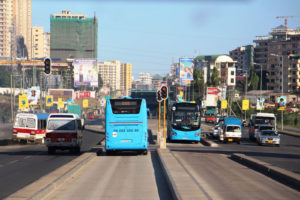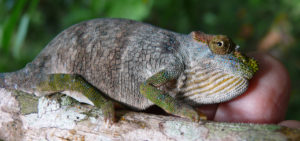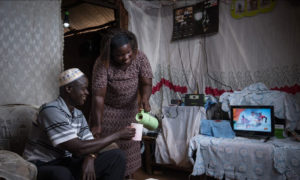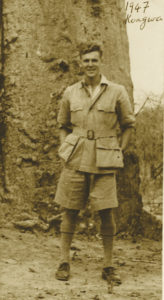by Donovan McGrath
How an emerging African megacity cut commutes by two hours a day
(Guardian online UK) Could Dar es Salaam’s experiment with Africa’s first ‘gold standard’ bus rapid transit system offer an alternative to a future dependent on private cars? … Extract continues: Dusk falls in Dar es Salaam, and for hundreds of thousands of people in this African megacity-to-be the daily chaos and frustration of the journey home begins. People cram themselves into daladala minibuses … So far, so normal for a sprawling megalopolis of 6 million with virtually no public transport and only eight lanes of major road heading to and from the centre. Dar es Salaam, the de facto capital of Tanzania, is one of the fastest growing cities in Africa. Its population has increased eightfold since 1980 and swells by half a million people every year… But Dar es Salaam is pinning its hopes on a solution that could offer a different model for Africa’s megacities … Unlike many cities on the continent, Dar es Salaam isn’t trying to build a metro… but a more achievable route: the bus… Outside the city centre many rely on boda boda motorbike taxis … Their safety record is notorious… The Dart system boasts bus lanes separated from other traffic … ticket payment and control takes place at stations rather than on board … The average journey time from the centre to the terminus at Kimara has been slashed from two hours each way to just 45 minutes, according to sustainable transport group the ITDP … The ITDP awarded the system Africa’s only “gold standard” bus rapid transit (BRT) rating… (8 January 2019)
Tanzanians with albinism embrace a life beyond stigma and superstition
(Guardian online UK) In a country where myths about albinism can have deadly consequences, an organisation set up to battle discrimination is having a profound impact. Extract continues: Paschal Merumba has suffered prejudice from the day he was born. His mother refused to breastfeed her “cursed” baby, the second child in the family born with albinism; the first had already died of neglect… In 2013, Merumba was attacked by men who tried to kill him… He was saved when a neighbour ran screaming towards the group with a torch… “My life was spent in darkness,” says Merumba… Now 54, his life changed after meeting with Alex Magaga, who had worked on the BBC documentary, In the Shadow of the Sun, which tells the story of two Tanzanians with albinism… In parts of Tanzania, up to one in 1,400 people has albinism … Many die of skin cancer before the age of 40 … The myths and misperceptions surrounding albinism in Tanzania are “almost too numerous to count”, says [Sam] Clarke [Standing Voice’s communications manager – an organisation that defends the rights of people with albinism]… In Tanzania, 75 albinos were killed between 2000 and 2016… (23 January 2019)
Chimpanzees develop distinct local cultures, and we’re destroying them
(Washington Post online USA) Extract: The chimpanzees of Tanzania may be the most famous tool users in the animal kingdom. Famed primatologist Jane Goodall first observed them in the 1960s using grass sticks to “fish” for termites in their mounds. But since Goodall, other scientists have discovered that chimps have more than one way to catch a termite. Those in Congo, for instance, gnaw on the end of their tools of choice to turn them into paintbrush-like instruments, which seem able to catch even more termites than straight-tipped rods. In Uganda, some chimpanzees simply break into termite mounds with their hands. Everywhere chimpanzees roam, scientists are uncovering more fascinating behaviours such as harvesting algae with long poles, mining honey out of the ground using sticks and accessing hidden reserves of water inside trees with sponges fashioned from chewed-up leaves. These and other behaviours make up the basis of what scientists increasingly describe as chimpanzee “culture” – learned traditions that vary by location. And humans might be killing it, according to a study . . . in the journal Science. The study suggests that people and their disturbances of ecosystems may be hindering the transmission of chimpanzee culture, and in some cases, destroying it altogether. . . [M]ore than 75 scientists and other researchers compiled data from 144 chimpanzee communities found across 15 countries in West and Central Africa. . . Chimpanzees living in areas with the most human disturbance had less varied behavioural repertoires, the study found… The idea that chimpanzees possess distinct cultures is still relatively new … (7 March 2019)
Meet Tanzania soccer freestyle queen who earned praise from President Trump
(CNN online USA) Extract: Tanzania rarely features in discussions of Africa’s soccer hotspots. But that perception might be changing thanks to the skills of soccer freestyle queen Hadhara Charles, which are winning plaudits from celebrities across the world including US President Donald Trump. A viral tweet of Charles displaying her range of flicks and tricks in a dress and flip-flops has been watched more than 10 million times, earning 125,000 retweets and more than 400,000 likes. President Trump was among those impressed, tweeting “Amazing!” just after a message in which he accused former FBI director Andrew McCabe of treason. British television host Piers Morgan also shared the clip with the comment “Brilliant.” The star herself was pleased to receive acclaim from such high-profile quarters. “It feels good that Donald Trump shared the video,” Charles told CNN.
“Here I am not paid. Sports doesn’t pay.” Charles, a mother of two, is a specialist in the art of freestyle soccer, which is based on juggling and tricks with the ball using any part of the body. Freestyle has become a popular pursuit around the world and the leading exponents compete in prestigious international championships… The freestyler has won acclaim in her home country and represents Tanzania in events in Gabon, Cameroon, South Africa and Ethiopia. In 2018, Charles came third in the first African Freestyle Football Championship. But prestige has not been accompanied by financial rewards for Charles, who still struggles to support her family. “I get these opportunities to travel but no pay,” she says. “If only I had sponsorship or some deal to support myself it will work form me (and) my two children will have enough for food and basic needs.” … Recognition from President Trump offers a moment of satisfaction for Charles. But her true ambition is to make those magical skills deliver a more comfortable life for her family. (26 February 2019)
Tanzanian ref banned for life by Fifa for taking bribes
(BBC online UK) Extract: One of Tanzania’s top referees has been handed a life ban from football after Fifa found him guilty of taking bribes. The case, opened in July 2018, was handled by Fifa’s Ethics Committee which ruled Oden Charles Mbaga had breached the Fifa Code of Ethics. Fifa told Reuters that the ban relates to bribes “to manipulate several national and international matches between 2009-2012” … Speaking from Dar es Salaam, Mbaga told the news agency he was questioned by Fifa in 2010 but had not heard anything since and knew nothing about match-fixing. “This is shocking news to me,” he said… Mbaga has also been fined $200,000. He has been banned for life from all football-related activities, not just refereeing, at national and international level… [F]ormer international referee Ibrahim Chalbou from Niger was also banned for life and fined $200,000 after being found guilty of taking bribes … (27 February 2019)
Tanzania male MPs face circumcision call to stop HIV spread
(BBC online UK) A female MP in Tanzania has called for checks to determine whether or not her male colleagues have undergone circumcision – a procedure known to reduce the risk of HIV transmission. Extract continues: Jackline Ngonyani said any MPs found not to have been circumcised should be required to undergo the procedure. Her suggestion divided opinion among her colleagues. HIV is seen as a major threat to public health in Tanzania. Around 70% of the male population is circumcised. Around 5% of Tanzania’s adult population is believed to have been infected by HIV – giving it the 13th highest rate of infection in the world, according to figures from 2016. The World Health Organization (WHO) says circumcision reduces the risk of heterosexual men contracting HIV by around 60%. Several African countries that are fighting HIV epidemics have launched campaigns to encourage men to undergo the procedure, which involves surgically removing the foreskin from the penis. Ms Ngonyani made the comments during a debate in parliament … Her suggestion was backed by MP Joseph Selasini… However, MP Joseph Kasheku opposed Ms Ngonyani’s proposal, describing it as uncouth and invasive. (6 February 2019)
Unique Tanzania forest granted official protection after research reveals it is on brink of collapse
(Independent online UK) ‘When I first began work in the forest 15 years ago it was clearly a biologically important place, but it rang with the sound of axes and machetes,’ says project leader. Extract continues: The Tanzanian government has agreed to set aside a unique forest as a new nature reserve after research revealed it was about to be wiped out for good. Magombera forest is home to a recently discovered species of chameleon and threatened animals including bush babies and elephants. But illegal logging and poaching have pushed the valuable ecosystem to the brink of destruction, with some estimates predicting it was on the brink of total destruction… Tanzanian authorities has reached the $1m (£0.78m) required to protect the land. The value of the forest has been recognised for many years. . . Thousands of trees are already growing back in areas of forest that had been stripped bare. The newly created 6,463 acre Magombera Nature Reserve houses an enormous amount of species within a relatively small area, and is considered among the most biodiverse forests in Africa… (17 January 2019)
Mnyamawamtuka: Scientists discover new dinosaur with heart-shaped tail

Reconstruction of a pair of M. moyowamkia in a rainstorm in Tanzania during the Cretaceous Period. (Mark Witton)
(Independent online UK) Extract: The plant-eating dinosaur was discovered in Africa and reportedly lived 100 million years ago. . . Apart from its vast size, the 30-foot dinosaur also displayed another fascinating feature – heart-shaped bones in its tail. Researchers named the dinosaur Mnyamawamtuka Moyowamkia from Swahili for “animal of the Mtuka” and “heart-shaped tail” and joked that the animal “wore it’s heart on its tail.” In addition to its unique bone structure, the discovery of the dinosaur’s remains, which were found in a riverbed in the East African Rift system of Tanzania, allows scientists to piece together information about how ecosystems evolved in Africa during the Cretaceous period. Previously, titanosaurs were identified in South America, but the new species discovered in Tanzania, Egypt and other parts of the African continent offer a more complex picture of their evolution… The new dinosaur … is one of three new titanosaurs to be found in the area… The fossilised bones of the dinosaur … suggests the animal also shared similarities with another dinosaur “Malawisaurus, from just across the Tanzania-Malawi border,” according to Dr Gorscak [research associate, and professor at Midwestern University]. The researchers also discovered other animals in the East African Rift, including relatives of early crocodiles and evidence of “insect farming” from fossilised termite nests, as well as clues about the evolution of monkeys and apes. “The African story is far from over …” (13 February 2019)
Canadians bring solar power to off-the-grid Africa
(Global and Mail online Canada) M-Kopa and Jaza Energy take different approaches, but their founders agree there is plenty of room for expansion in East Africa. Extract continues: Jaza Energy and M-Kopa, both started by Canadians, are bringing small-scale solar energy to communities in Tanzania and, in M-Kopa’s case, to Kenya and Uganda as well. Their main line of business is similar, and it’s one that the long term may be potentially disruptive for utilities in developed countries. Both firms deal in distributed generation – providing on-site, off-the-grid electricity that can be installed cheaply and quickly and which doesn’t necessarily require giant infrastructure such a power plants or transmission lines… “Our customers pay the equivalent of about 50 cents a day, making payment by phone. Over time, within a year or two, they are buying their solar system from us, in the same way as you would take a mortgage from a bank and buy your house,” [says Jesse Moore, M-Kopa’s CEO]. M-Kopa … has connected more than 700,000 homes in East Africa to solar power, with 500 homes added every day. The company says that by using solar power to light homes, its customers save the equivalent of 75-million hours of kerosene that would otherwise be burning, emitting fumes and contributing to climate change. Jaza, started in 2016, is smaller than M-Kopa, powering about 2,000 households, or about 10,500 people in Tanzania. It sets up its power units through small-scale retail hubs, often run by women, which are both sales points and solar-powered recharging stations. Customers take their removable power batteries to the local hub each week to swap… Unlike M-Kopa, Jaza doesn’t rely on mobile phones for payment … Swapping Jaza’s batteries costs households the equivalent of 55 cents Canadian each week, so it is indeed cheaper than M-Kopa’s panels… (17 January 2019)






